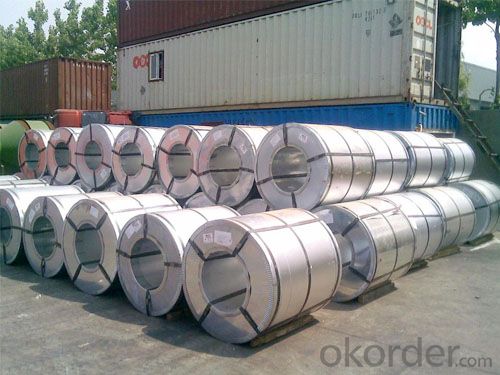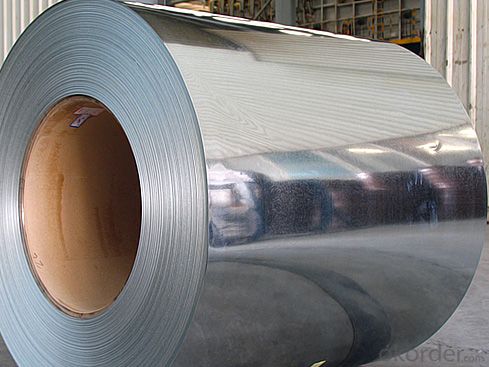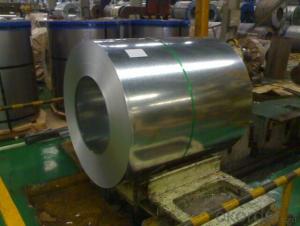Hot-Dip Galvanized Steel Coil-SGC340 in Low Price
- Loading Port:
- China main port
- Payment Terms:
- TT OR LC
- Min Order Qty:
- 50 m.t.
- Supply Capability:
- 10000 m.t./month
OKorder Service Pledge
OKorder Financial Service
You Might Also Like
Hot-Dip Galvanized Steel Coil-SGC340 in Low Price
Brief Introduction
Hot-Dip galvanized steel coils are available with a pure zinc coating through the hot-dip galvanized process. It offers the economy, strength and formability of steel combined with thecorrosion resistance of zinc. The hot-dip process is the process by which steel gets coated in layers of zinc to protect againstrust. It is especially useful for countless outdoor and industrial applications, such as roofing, cladding, decking, tiles, sandwich walls, airconditioning duct as well as electrical appliances and engineering.
Image


Main Specification
HOT DIP GALVANIZED STEEL | |
THICKNESS | 0.13-0.8MM |
WIDTH | 900-1250MM |
ZINC COATING | 60-275g/m2 |
COIL ID | 508MM OR 610MM |
SURFACE TREATMENT | CHROMATED/UNCHROMATED, OILED/DRY |
COIL WEIGHT | 1-12MT |
Application
Galvanizedsteel coil/sheet products are mainly used in construction, light industry,automobile, farming and commercial fishing industries.
Which construction industry, mainly used in the manufacture of industrial and civil corrosion roof, roof grille.
Light industry with its manufacture appliance housing, civil chimney, kitchen utensils, automotive industry, mainly for the manufacture of car parts andother corrosion-resistant; husbandry and fishery owners do use food storage,frozen meat and aquatic products processing equipment, etc. Business mainlyused as storage and transportation of materials, packaging equipment, etc.
Package &Delivery
Packagedetails: Standard seaworthy packing for international delivery.
Delivery:According to the exact quantity of your order.
FAQ
1.How to guarantee the quality of the products?
We have established the international advanced quality management system,every link from raw material to final product we have strict quality test;We resolutely put an end to unqualified products flowing into the market. At the same time, we will provide necessary follow-up service assurance.
2. How long can we receive the product after purchase?
Usually within thirty working days after receiving buyer’s advance payment or LC. We will arrange the factory manufacturing as soon as possible. The cargo readiness usually takes 15-25 days, but the shipment will depend on the vessel situation.
- Q: What are the common coil transportation methods?
- The common coil transportation methods include using flatbed trucks, coil racks, coil cars, and coil trailers.
- Q: I am using mild steel wire (very thin and bendable) for an art project, and would like to know if using a soldering torch is effective enough to get the job done. Or do I have to use a butane torch to heat the metal?BTW, is it better to use soft or hard solder?
- steel wire has to be silver soldered, or brazed ,or spot welded, you can not solder it, with reg solder or a soldering iron, use a small torch, like a pencil torch,
- Q: i know that steel helmets werent meant to stop bullets, but i was wondering do they have an value whatsoever for stopping bullets, or is that just yet another thing that hollywood made up(like the omaha beach scene in saving private rian)
- They are meant to protect from shrapnel and flying objects,or an enemy's hit to the head. Not meant for protection against bullets [we didn't think so] but at the right angle you could get lucky. What they are useful for is boiling water for coffee etc. Shaving taking a who/e's bath and in the field very handy to have. The bad thing about pots is wearing,you must get accustomed to the weight on your head and neck. You don't think you ever will but finally you do,and because it's many uses and you must wear it,you do!
- Q: What are the different methods of shearing steel coils?
- There are several different methods of shearing steel coils, each offering its own unique advantages and disadvantages. Some of the most common methods include: 1. Guillotine Shearing: This method involves using a guillotine-like machine with a blade that moves vertically to cut through the steel coil. Guillotine shearing offers high efficiency and accuracy, making it suitable for large-scale industrial production. However, it may cause deformation or burrs on the cut edges. 2. Rotary Shearing: In rotary shearing, a set of rotating blades is used to cut through the steel coil. This method allows for continuous cutting, making it ideal for high-speed production lines. It provides a clean and precise cut, but it requires regular maintenance and sharpening of the blades. 3. Slitting: Slitting involves passing the steel coil through a set of circular blades that make multiple parallel cuts. This method is commonly used to produce narrower strips from wider coils. It offers high precision and can produce multiple strips simultaneously. However, slitting may cause edge burrs or camber on the strips. 4. Laser Cutting: Laser cutting uses a high-powered laser beam to melt or vaporize the steel coil along a pre-determined path. This method offers exceptional precision and can cut complex shapes or patterns. It is commonly used for specialized applications where accuracy is crucial, although it can be relatively expensive. 5. Waterjet Cutting: Waterjet cutting utilizes a high-pressure stream of water mixed with abrasive particles to cut through the steel coil. This method is versatile and can handle various materials and thicknesses. It is especially useful for cutting heat-sensitive materials or for applications requiring minimal distortion. 6. Plasma Cutting: Plasma cutting involves ionizing a gas to create a plasma arc that melts and blows away the steel coil. This method is fast and efficient, suitable for cutting thick steel coils. However, it may produce a wider heat-affected zone compared to other methods. 7. Electrical Discharge Machining (EDM): EDM uses electrical discharges to erode the steel coil and create the desired shape. This method is commonly used for intricate or delicate cutting tasks that require high precision. It is particularly effective for hard materials. Each method of shearing steel coils has its own set of advantages and limitations, and the choice depends on factors such as the required precision, speed, material thickness, and the desired end-product.
- Q: What is the role of steel coils in the supply chain?
- Steel coils play a crucial role in the supply chain as they are used for a variety of purposes, such as transportation, storage, and manufacturing. They serve as a convenient and efficient way to transport large quantities of steel, ensuring that it reaches its destination safely and in optimal condition. Additionally, steel coils facilitate storage by allowing for easy stacking and organization, maximizing space utilization. Moreover, they are a primary raw material for various industries, especially manufacturing, where they are used in the production of a wide range of products, including automobiles, appliances, construction materials, and more.
- Q: What are the common uses of stainless steel coils?
- Stainless steel coils have various common uses in different industries. Some of the most common applications include manufacturing of kitchen appliances, automotive parts, construction materials, and medical equipment. Additionally, they are used in the production of pipes, tubes, and wire products, as well as in the food and beverage industry for processing and storage equipment.
- Q: How are steel coils used in the production of steel framing systems?
- Steel coils are used in the production of steel framing systems as they are typically unwound and fed into a roll forming machine where they are shaped into the desired profiles and sizes required for the framing components.
- Q: I just want regular steel, not stainless steel.
- Iron is the primary ingredient in steel. All Steel is an alloy by definition. Stainless steels are alloys that resist corrosion. There are dozens of alloys of steel. Many stainless steels are not magnetic. If a magnet won't stick to it it is very likely to be a stainless steel but that is not true for all stainless steels. You really do need to be more specific as to what you want and why. There are too many to chose from.
- Q: What are the challenges in coil leveling for high-strength steel?
- Achieving optimal results in coil leveling for high-strength steel involves addressing several challenges. The steel's inherent hardness and strength present one of the main obstacles. High-strength steel is designed with enhanced mechanical properties, including tensile strength and hardness, making it difficult to deform and shape. To overcome the steel's high-strength nature, specialized leveling equipment is needed. This equipment must exert sufficient force to counter the steel's resistance to deformation. This may involve using stronger and more durable leveling rollers or increasing the pressure applied during the leveling process. Failing to apply the appropriate force can result in incomplete leveling, leading to residual stress and dimensional inaccuracies in the final product. Another challenge in coil leveling for high-strength steel is the potential for springback. Springback refers to the material's tendency to return to its original shape after being deformed. High-strength steel is especially prone to springback due to its higher elastic modulus. This can result in uneven leveling and dimensional variations in the coil. To mitigate springback, advanced leveling techniques can be utilized. These techniques include overbending and pre-bending the steel. Overbending involves bending the steel beyond the desired level, allowing it to spring back to the desired shape. Pre-bending, on the other hand, involves intentionally bending the steel in the opposite direction before leveling it, counteracting the effects of springback. These techniques require precise control and expertise to ensure accurate leveling. Additionally, high-strength steel often has a more pronounced yield point. The yield point is the stress level at which permanent deformation occurs. This can make it challenging to achieve consistent and uniform leveling throughout the coil. Proper adjustment of the leveling equipment and careful monitoring of the leveling process are necessary to effectively address this challenge. Furthermore, high-strength steel coils are often thinner and more sensitive to surface imperfections. Careful regulation of the leveling process is crucial to avoid causing damage to the steel surface, such as scratches or indentations. This may involve using softer leveling rollers or implementing protective measures, such as cushioning materials or coatings, to prevent surface defects. In summary, the challenges in coil leveling for high-strength steel revolve around its inherent hardness, springback tendencies, yield point behavior, and sensitivity to surface imperfections. Overcoming these challenges requires specialized equipment, advanced leveling techniques, precise control, and expertise to ensure accurate and high-quality leveling results.
- Q: How are steel coils inspected for quality control purposes?
- Steel coils are inspected for quality control purposes through various methods such as visual inspection, dimensional checks, and non-destructive testing techniques. Visual inspection involves examining the surface of the coil for any defects or irregularities. Dimensional checks are conducted to ensure that the coil meets the specified thickness, width, and length requirements. Non-destructive testing techniques like ultrasonic testing or magnetic particle inspection are used to detect internal flaws or defects in the steel coil. These inspection methods help ensure that the steel coils meet the desired quality standards before they are used in various applications.
Send your message to us
Hot-Dip Galvanized Steel Coil-SGC340 in Low Price
- Loading Port:
- China main port
- Payment Terms:
- TT OR LC
- Min Order Qty:
- 50 m.t.
- Supply Capability:
- 10000 m.t./month
OKorder Service Pledge
OKorder Financial Service
Similar products
Hot products
Hot Searches
Related keywords




























